Glen Hooker 1939 Mercury
THE CARIBBEAN
One of the most beautiful Customs created by the Valley Custom Shop is this 1939 Mercury convertible restyled for Glen Hooker of Burbank, California, in the early 1950’s.
Special thanks to Gordy Brown for the help on this article.
The Valley Custom Shop is known for their fine Custom Car designs and finely crafted creations. The car in this CCC-Article, the Glen Hooker 1939 Mercury convertible is no exception. The end-result is a very well balanced sporty looking Custom Car created on a budget. Lets take a look at how this stunning looking and well published custom was styled and built by the team at the Valley Custom Shop in Burbank, California.
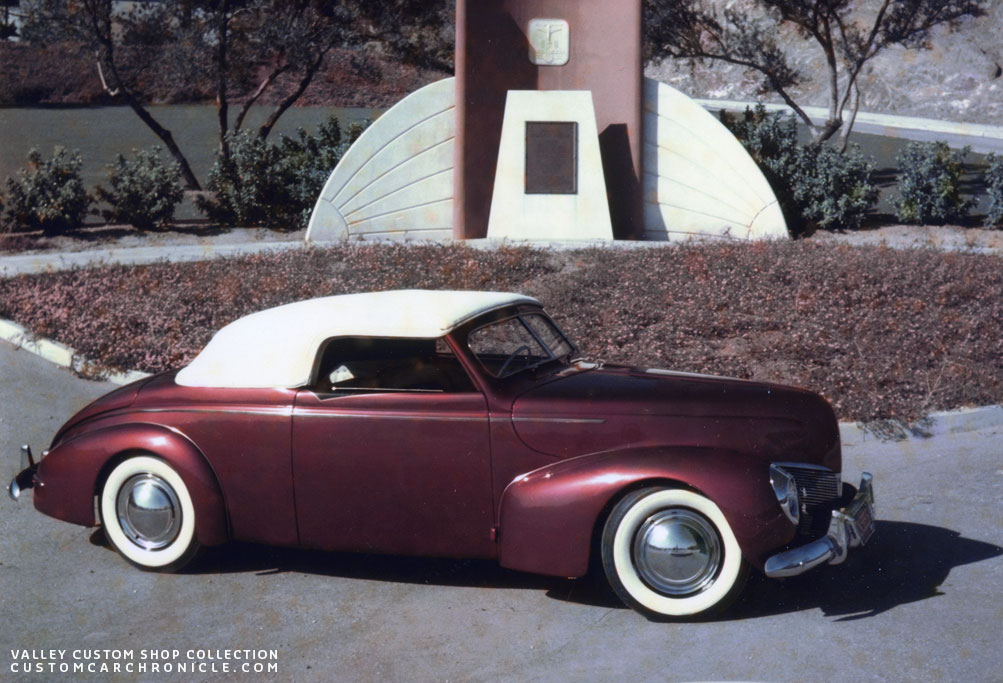 Faded color photo shows the wonderful thin profile of the restyled Mercury. This photo also shows an earlier paint version with a small black graphic element on the door, above the belt line.
Faded color photo shows the wonderful thin profile of the restyled Mercury. This photo also shows an earlier paint version with a small black graphic element on the door, above the belt line.
[divider]
Glen Hooker was 15 years old and already day dreaming of have a cool looking convertible custom for the time when he would be old enough to drive. He even knew who could do the custom work for his dream car. The guys that married two of Glen’s older sisters, Neil Emory and Clayton Jensen co-owners of the Valley Custom Shop. Glen worked at the shop in his spare time sweeping the floors, sanding the cars and all other jobs he could do. This way he hoped that his uncles would one day perhaps help create his dream custom.
Glen’s grandfather also knew about his custom convertible dreams, and had been on the lookout for an affordable older model. When he came across an slightly damaged 1939 Mercury convertible for a very good price, he bought it as a gift for Glen. The car was taken to the Valley Custom Shop and plans for the restyling were discussed.
Neil and Clayton had already created some very elegant Customs, before they started on Glen’s Mercury. One of them was the sectioned 1940 Ford convertible for Ralph Jilek. A well proportioned convertible with opened op wheel openings, for a more elegant look. For Glen’s Mercury the team wanted to try to get something similar in looks, but without the very time consuming task of actually sectioning the body. Glen’s had to be build on a budget. They succeeded very well, and quite a few people actually believe the body was sectioned to get the desired look. But this is not the case.
The plan was simple, remove the running-boards, drop the body over the frame and reduce the height of the fenders. Chop the windshield and add a low profile padded top to give the car a much more sporty feel. The execution however was still a little more complicated than that. The car the team started with had some front end damage, which was fixed by installing a set of front fender, a hood and the grille of a 1940 Mercury. 1940 parts where chosen since they looked more streamlined, than the stock 39 components and these would fit better with the rest of the planned restyling. The Mercury, like many other Valley Custom Shop created Custom Cars would not get the so popular on Customs from this type tear drop fender skirts.
 Most likely this old shop photo shows the Glen Hooker Mercury in its early stages with Neil Emory working on the A-Pillars. Clayton Jensen can be seen with his hat on working on the front fender of another car on the far right in the photo.
Most likely this old shop photo shows the Glen Hooker Mercury in its early stages with Neil Emory working on the A-Pillars. Clayton Jensen can be seen with his hat on working on the front fender of another car on the far right in the photo.
[divider]
The team decided the car should be channeled 3 inches. This way the lower points of the body would still be protected by the frame rails. The floor was cut out and the frame attachment points removed. A 3 inch section was removed from the firewall, so that the body could be dropped over the frame. The floor and frame attachment point were welded back into the body, and the fire wall reconnected. The rear of the car was still not low enough so the rear of the frame was z-ed around 5 inches, enough for the drop, and create more travel space for the rear axle. At the front a 2.5 inch dropped axle was installed. The car now had the desired ride height and it then was time to get started on reshaping the fenders which was needed after the channeling and removal of the running boards.
 This early version of the car also did not have the chrome plated rock shield installed. Possibly some rocks had damaged the paint and the car was partly repainted.
This early version of the car also did not have the chrome plated rock shield installed. Possibly some rocks had damaged the paint and the car was partly repainted.
[divider]
Version one
On previous chaneling jobs the Valley Custom Shop team had often raised the fenders to compensate for the body over the frame drop. But this time the team wanted a more sleaker look for the convertible. They decided to leave the fenders in the stock location, but cut of the botom of the fenders in such a way that the bottom of the fenders was now level with the lower edge of the main body. The new profile now looked very nice and streamlined, but now the tires were all the way up into the fenders, which looked not very attractive on the streamlined car, plus the front could not steer no more.
The wheel openings were radiused and raised up into the fenders to match the tire shape. The new opening was cut slightly less large, and the last about half inch was folded in and hammer finished to give the new opening a factory finished looking a typical Valley Custom Shop way. All four fenders received the same treatment. The cut off bottom and the enlared wheel openings had resulted in a set of wonderful stylish teardrop shaped ellegant looking fenders.
 Clayton Jensen at work finishing the new rear fender wheel opening.
Clayton Jensen at work finishing the new rear fender wheel opening.
[divider]
By now the car had taken on a complety different feel than the heavy looking stock Mercury the team started with. The whole process of chaneling the body over the frame z-ing the frame and reshaping the wheel openings was covered in two 7 page how to articles in the Jan and Feb issue of Car Craft magazine in 1954.
 The January 1954 issue of Car Craft Magazine used no less than 7 pages for the first part of the two part how-to article on channeling the frame.
The January 1954 issue of Car Craft Magazine used no less than 7 pages for the first part of the two part how-to article on channeling the frame.
[divider]
 A month later, in the February issue the magazine spend another 7 pages for part two of the Here’s How article. Great publicity for the Valley Custom Shop.
A month later, in the February issue the magazine spend another 7 pages for part two of the Here’s How article. Great publicity for the Valley Custom Shop.
[divider]
Glen was able to locate an used Carson Padded Top which could be reused for his Mercury. They used the padded top to mark the amount taken from the windshield height, which turned out to be about 2.5 inches. Even though Glen wanted to drive the car with an open top most of the time it was a wise decision to include the chopped padded top in the whole package as well. With the top up, the car’s looks changes completely.
The 1940 Mercury hood was restyled with a peaked front, which made it necessary to create an inboard latch to open the hood. The two trim pieces on the lower edges of the hood matching the grille were removed and the hood bottom edge was flared out to meet the hood and front fenders. To further enhace the more elegant look of the convertible, a 1946 Chevy bumper was added front and rear. At the rear 1941 Studebaker tear-drop shaped taillight were mounted turned 90 degrees from original. they were mounted very low on the rear fenders, just above the Chevy bumper. The fenders were not molded in to the body, like most of this type of custom cars had back in the day. The fenders were left separate and would later be detailed by adding chrome fender welting. Which gave it a very classic look.
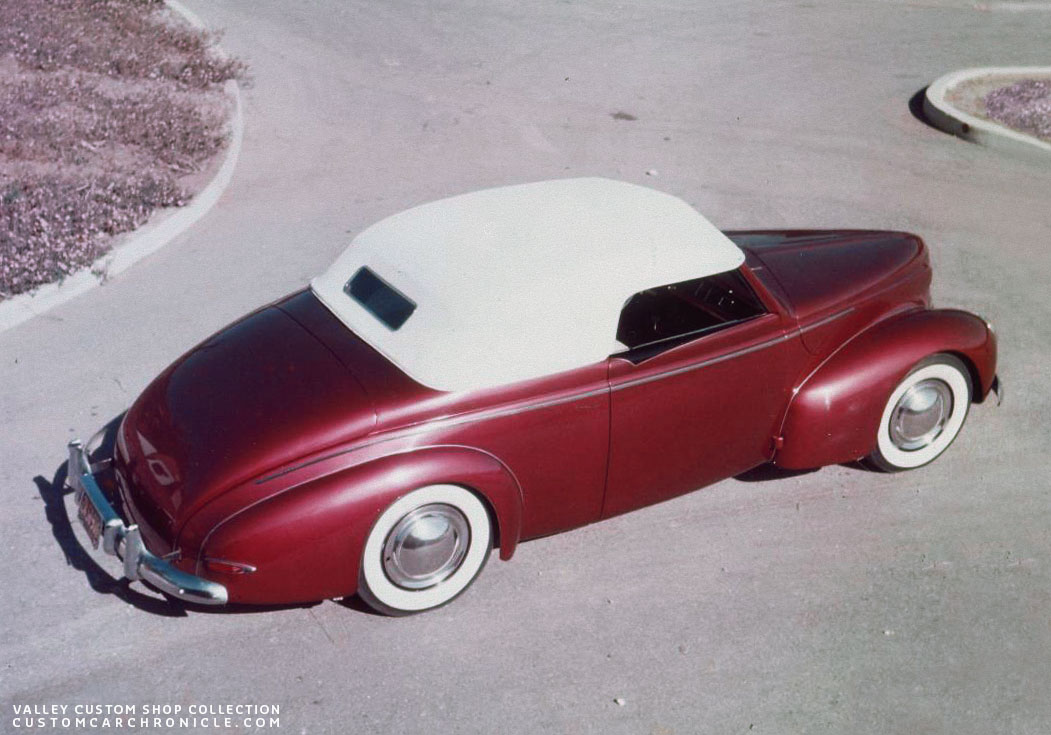 Another photo showing the small graphic element on the door only creating the optical “Darrin” dip. This high point-of-view shows of the elegant appearance of the restyled mercury really well.
Another photo showing the small graphic element on the door only creating the optical “Darrin” dip. This high point-of-view shows of the elegant appearance of the restyled mercury really well.
[divider]
 1954 photograph from the Los Angeles Public Library photo shows; left to right are “Burbank’s Tsuki-Teru Car Club president Dick Lewis and vice president Glen Hooker with Glen’s Mercury. It looks like there is no graphic below the side trim in this photo, so this must be the early version of the car.
1954 photograph from the Los Angeles Public Library photo shows; left to right are “Burbank’s Tsuki-Teru Car Club president Dick Lewis and vice president Glen Hooker with Glen’s Mercury. It looks like there is no graphic below the side trim in this photo, so this must be the early version of the car.
[divider]
The body was releived of all the handles and most of the trim except the belt-line trim, which was left on, but shortened in the front. Then it was time for the paint. A titian maroon (1953 Buick) color was chosen. And what makes this color even more special is the way it was used. The color was mixed in such a way that it was highly transparent, almost like a candy paint, and each layer added created more depth in the paint. There are a few photos showing the car with a small graphic element in black with white outline on the doors, to create an optical “Darrin” dip in the doors. This was later changed to a similar style graphic element below the side trim to create more optical swoop towards the rear of the car. Later the lower edge of the rear fenders are protected by a hand formed and chrome plated rock shield.
 The March 1954 two page article in Car Craft magazine shows the first finished version of the car. “Darrin” dip graphic on the door, and no rock shields on the rear fenders.
The March 1954 two page article in Car Craft magazine shows the first finished version of the car. “Darrin” dip graphic on the door, and no rock shields on the rear fenders.
[divider]
On the inside, the art-deco styled 1939 Mercury dash was replaced with a 1940 Mercury unit dash, that has much more streamlined looks to fit the rest of the restyled body much better. The interior was upholstered in maroon and black Naugahyde by Bill Colgran’s Auto Upholstery shop. A set of wide white wall tires was fitted with a set of simple but elegant aftermarket hubcaps. These hubcaps have been used on several of the Valley Custom Shop created customs. And I have to say that on this car as well as on all other cars they used them on, it shows how perfectly shaped these hubcaps are. The perfect elegant detail for the new elegant look of Glen’s Mercury.
Version two
When the car was finished, Glen was still 15 years old and too young to drive. Gordy Brown, good friends with Glen, told us that Glen’s father had to drive the Mercury to the first car show it was entered. Glen’s mercury was featured in several magazines back in the day. The double Car Craft How-To feature, as mentioned earlier in this article, as well as a two page feature in the March 1954 issue of Car Craft magazine (with the first graphic and no rock shields on the rear fenders) and later after a few changes on the car for the second version, a full four page write up in the July 1955 issue of Rod & Custom, with the new belt-line graphics and chrome rock shields.
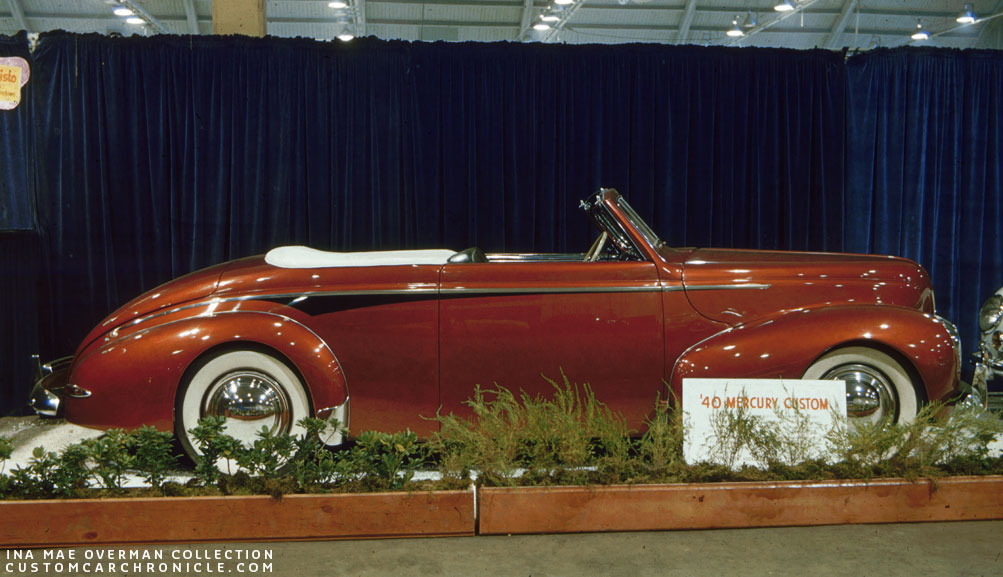 Ina Mae Overman took this great color slide at the 1954 Petersen Motorama show. It shows the new black graphics below the side trim.
Ina Mae Overman took this great color slide at the 1954 Petersen Motorama show. It shows the new black graphics below the side trim.
[divider]
 Close up of the photo shows the low mounted ’41 Studebaker lights, the chrome fender welting, the chrome plated rock shield on the front of the rear fender, and also that the black graphic was not yet outlined in white like it is on most of the photos of the car.
Close up of the photo shows the low mounted ’41 Studebaker lights, the chrome fender welting, the chrome plated rock shield on the front of the rear fender, and also that the black graphic was not yet outlined in white like it is on most of the photos of the car.
[divider]
 Glen with his Mercury in front of his parents house. By now the black graphic had been outlined in white. What a stunning car for a young guy to drive to school. Glen must have felt King of the road.
Glen with his Mercury in front of his parents house. By now the black graphic had been outlined in white. What a stunning car for a young guy to drive to school. Glen must have felt King of the road.
[divider]
 Four page article in the July 1955 issue of Rod & Custom magazine shows the car with the belt-line graphics and with the cars name The Caribbean.
Four page article in the July 1955 issue of Rod & Custom magazine shows the car with the belt-line graphics and with the cars name The Caribbean.
[divider]
After Glen sold the car to Bobby Daren in 1956 the Mercury was used in the movie A Strange Adventure. The car can be seen quite a bit in the movie, especially in the first part of it. The movie is about a trio of thieves make their getaway by kidnapping a young hot-rodder, and take over a mountain cabin for a hideout after overpowering its occupants. Director: William Witney, Writer: Houston Branch, Staring: Joan Evans, Ben Cooper, Marla English.
 Movie poster and promotional photo from A Strange Adventure.
Movie poster and promotional photo from A Strange Adventure.
[divider]
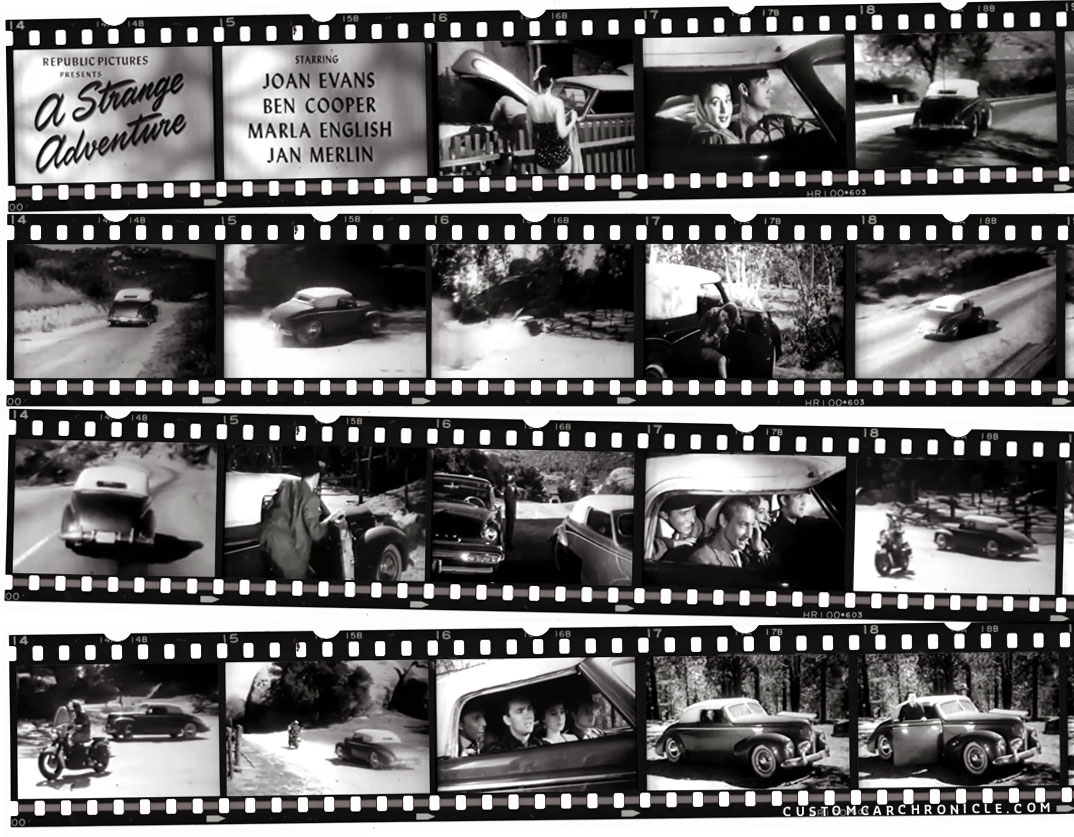 A few movie captures shows that Glen’s mercury was being driven pretty hard in the movie.
A few movie captures shows that Glen’s mercury was being driven pretty hard in the movie.
[divider]
 Profile photo with Glen in the driver seat, show how low, long and elegant the car looks. Thanks to the perfect proportions after the Valley Custom Shop restyling.
Profile photo with Glen in the driver seat, show how low, long and elegant the car looks. Thanks to the perfect proportions after the Valley Custom Shop restyling.
[divider]
 This photo gives us a good look at the peaked and reshaped lower edge of the hood.
This photo gives us a good look at the peaked and reshaped lower edge of the hood.
[divider]
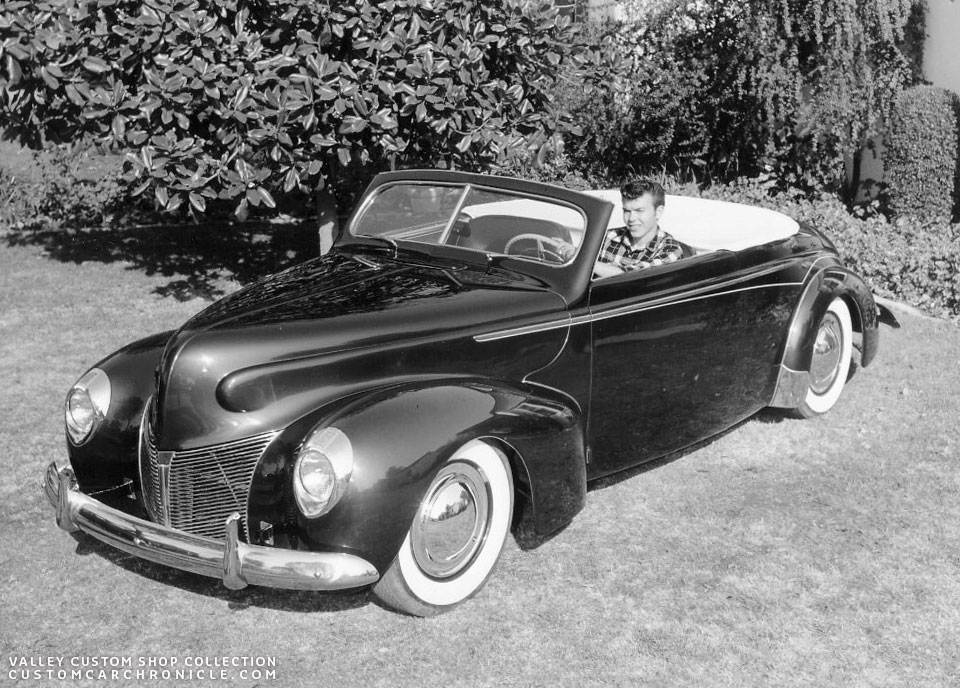 A tonneau was created to cover the section behind the front seat.
A tonneau was created to cover the section behind the front seat.
[divider]
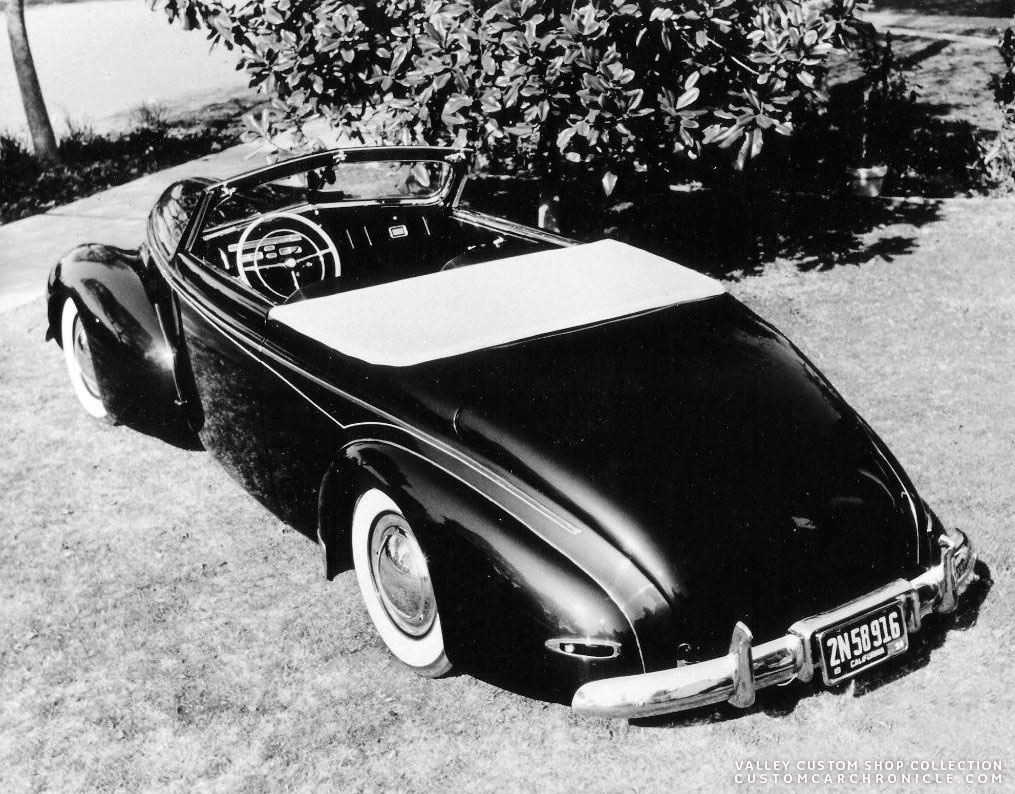 The window garnish moldings were chrome plated and the 1940 Mercury dash was enhanced with an Cadillac steering wheel. The clock in the glove box door was replaced with a custom made brass The Caribbean name plaque.
The window garnish moldings were chrome plated and the 1940 Mercury dash was enhanced with an Cadillac steering wheel. The clock in the glove box door was replaced with a custom made brass The Caribbean name plaque.
[divider]
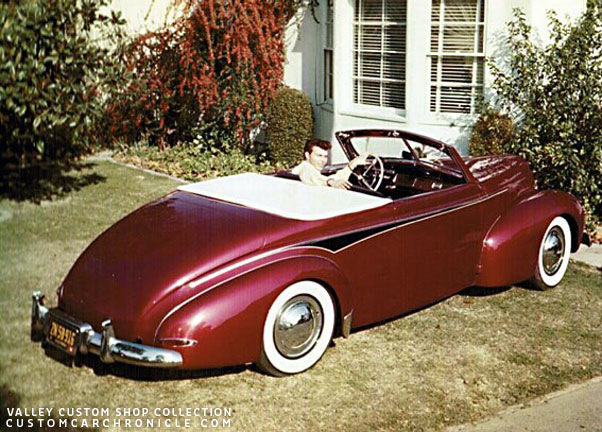
After Glen had sold the car in 1956 the car had a rough life. Gary Emory remembers that someone had told him the hood was badly damaged on the car when somebody dropped a bowling ball on the hood (which might explain the green hood when the car was found). Gary also remembers that by 1961 the car was painted white when it showed up at his high school. It looked very sad and it looked like someone drove a herd of cattle through the Interior!
 In December 2017 the American Hot Rod Foundation posted this photo of the Glen Hooker ’39 Mercury on their Facebook page. The photo comes from the Howard Hudson Collection and shows the car in the late 1950’s, but before 1961. The car in the background, is a 1958 Mercury. Notice how the car now has big and little white wall tires, a forward rake and its grille front bumper and hubcaps are missing.
In December 2017 the American Hot Rod Foundation posted this photo of the Glen Hooker ’39 Mercury on their Facebook page. The photo comes from the Howard Hudson Collection and shows the car in the late 1950’s, but before 1961. The car in the background, is a 1958 Mercury. Notice how the car now has big and little white wall tires, a forward rake and its grille front bumper and hubcaps are missing.
[divider]
The current state of the Mercury
What happened with the Mercury after the 1956 movie is a little vague. We know that the car was in the the Pacoima or San Fernando area in 1959. The then owner wanted to trade it for an hoped up 1952 Chevy owned by a 17 year old kid from North Hollywood. The kid’s father did not let his son trade the Chevy for an 13 year older model car. Something the kid still regrets today. Later the Mercury was painted white and somehow ended up wrecking yard in the California desert. In the late 1980’s the car was found by a car trader who bought it to make money on. He recognized the car as the Glen Hooker Mercury, contacted Glen to verify his find. Glen sure recognized his old love but could not afford the high price the seller wanted for the car. So it ended up for sale in Hemmings. No buyers, since the asking price was very high. And after a while the seller contacted Glen again and offered the car for a much reduce price. The new price was still up there, but Glen decided to buy it anyway. By then the car was located in Arizona where the car dealer was located. Glen asked his long time friend Gordy Brown to help him pick up the car and bring it to his home in Washington.
 On the way from Arizona to Washington. Gordy Brown’s pick up truck with Glen’s Mercury on the trailer.
On the way from Arizona to Washington. Gordy Brown’s pick up truck with Glen’s Mercury on the trailer.
[divider]
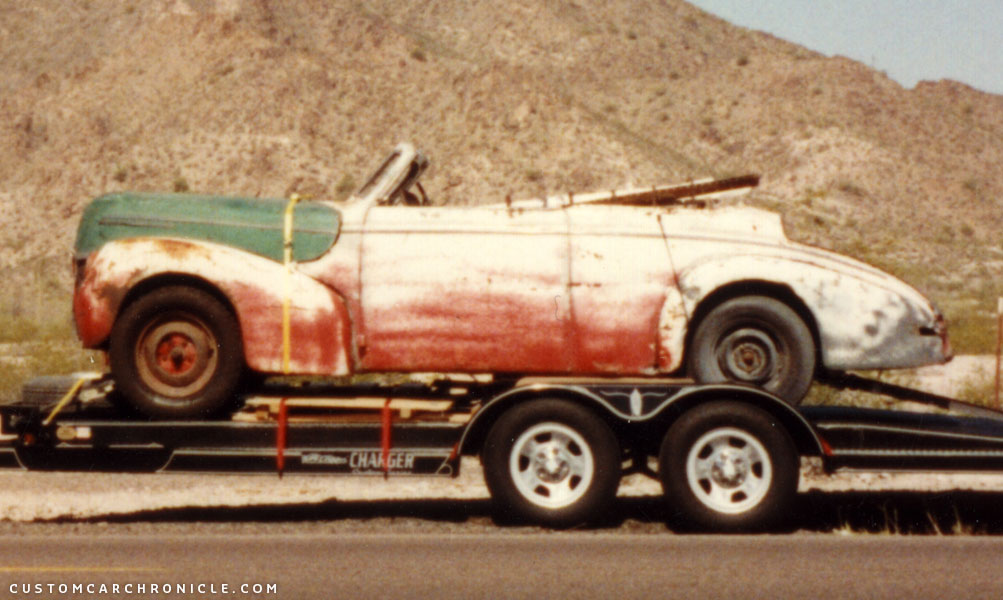 The car was not in perfect shape when Glen took here home, but there was nearly no rust. The hood got lost over time, probably used on another custom or hot rod and replaced by a stock unit. An early 1950’s Cadillac Engine is sitting on a pallet inside the car. (not visible in this photo)
The car was not in perfect shape when Glen took here home, but there was nearly no rust. The hood got lost over time, probably used on another custom or hot rod and replaced by a stock unit. An early 1950’s Cadillac Engine is sitting on a pallet inside the car. (not visible in this photo)
[divider]
On the way from Arizona to Glen’s home in Washington Gordy and Glen stopped at Gordy’s home in Salt Lake City, Utah. Gordy wanted to compare the original Caribbean with the inspired version on which he was working on the time. (You can read about this inspired version in the Second Mercury side bar). Glen and Gordy compared the two, took measurements and then put the original Mercury back on the trailer and took the car to Glen’s home.
 Glen Hooker comparing chops between the Caribbean ’39 Merc on the left and Gordy Brown’s ’40 Merc on the Right. (The ’40 Merc on the right has a ’39 grille, while the Caribean is a ’39 Merc with ’40 grille, to make it all rather confusing.)
Glen Hooker comparing chops between the Caribbean ’39 Merc on the left and Gordy Brown’s ’40 Merc on the Right. (The ’40 Merc on the right has a ’39 grille, while the Caribean is a ’39 Merc with ’40 grille, to make it all rather confusing.)
[divider]
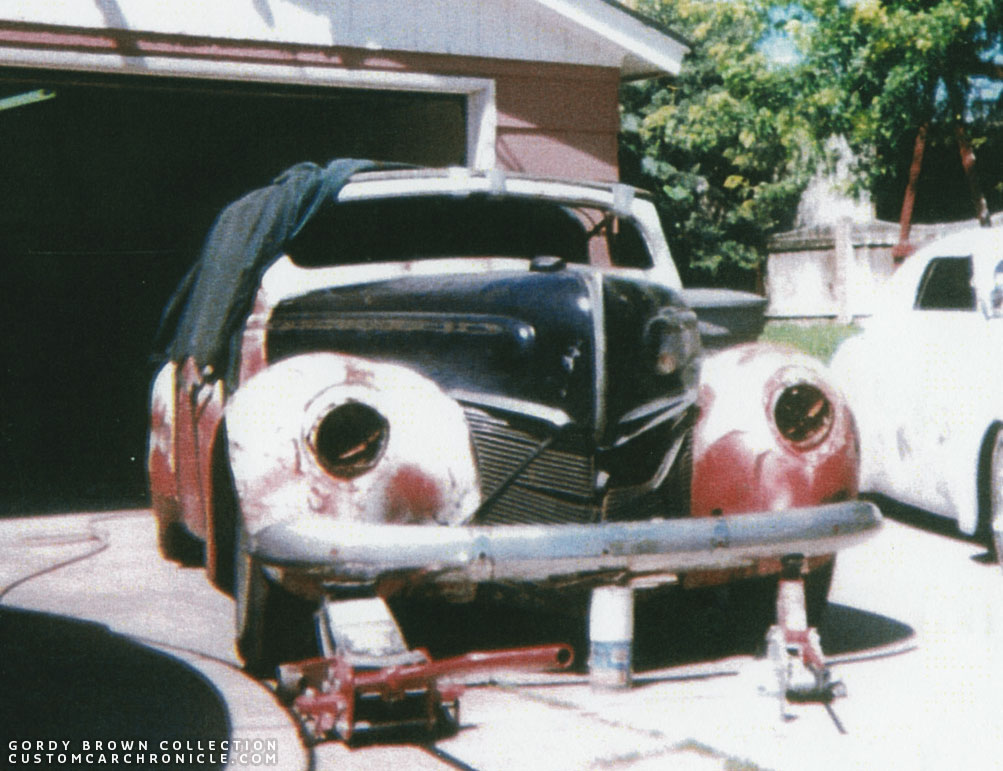 Gordy put the ’46 Chevy bumpers in place with jacks to get an feeling how it would look. To bad the original restyled hood is missing.
Gordy put the ’46 Chevy bumpers in place with jacks to get an feeling how it would look. To bad the original restyled hood is missing.
[divider]
After the guys got the Mercury home, Glen and Gordy spend about a week to strip the car, prep is and spray on some black primer. This would be the best base for the rest of the work Glen was planning. Then Glen consulted with Neil Emory to let him know he now owned his old car again. And to talk about possible restylings that could be done on the car. Neil said that the he always felt the hood was a little fuller than he would have liked it. And advised Glen the hood should be sectioned an inch, perhaps and inch and a half, to make the car flow and balance better. Glen accomplished this by lowering the cowl panel and sectioning the hood a little. At the same time Glen lowered the windshield opening down a little. When Glen had bought the car from the car dealer there was an complete early Cadillac engine and trans sitting on a pallet inside the car to replace the Flathead motor and trans. It was part of the deal. So this engine went in the car and Glen decided to use a Lincoln Versailles rear end with disc brakes and a aftermarket Mustang ll front crossmember with disc brakes to replace the old dropped axel. Glen was also going to use Air Ride suspension, but never got around to install that.
You have to remember that Glen was redoing this car to use as a driver not a restoration and wanted what he considered the very best at the time. He was redoing the car just as when the car was done originally with the best at that time and Neil agreed with him. When someone acquires an old Custom they are somewhat limited by what the car was, out of respect for the original builder and design. In this case Glen was the original owner and was conferring with the original builder to bring the car into the current time frame.
Due to some unfortunate events Glen had to leave Washington state in the late 1990’s and decided to sell the Caribbean. He first called his friend Gordy Brown and offered it to him. Gordy always loved the car, as well as wanting to help his old friend, so he bought the Mercury and picked it up to bring it to his Salt Lake City home. The car still looks pretty much the way it left Glen’s home in the late 1990’s. It is sitting in Gordy’s shop waiting to be completely restore one day.
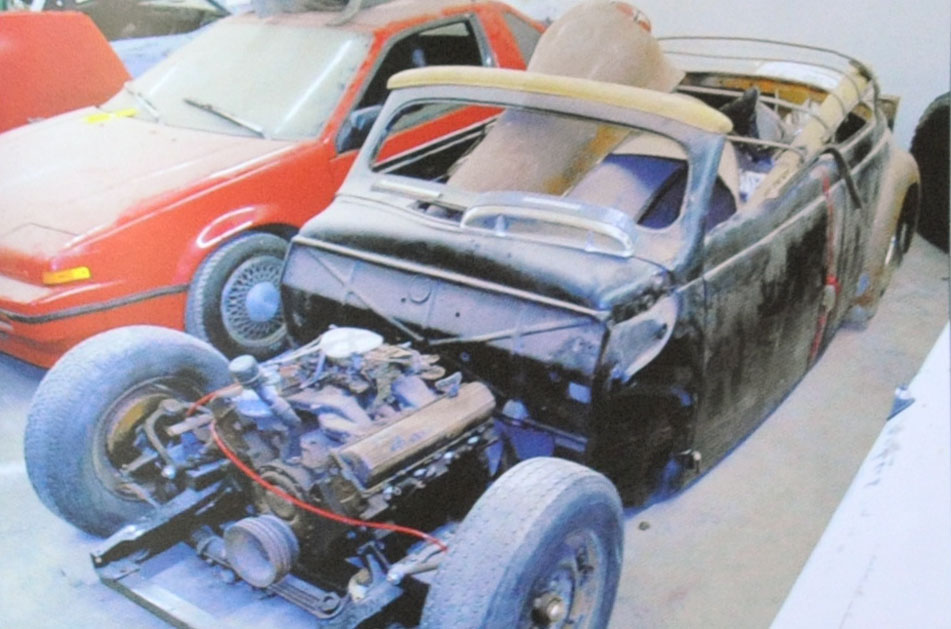 This is now the car currently sits in Gordy Brown’s shop. The Padded top frame is all there, but the padding and upholstery on the top are long gone.
This is now the car currently sits in Gordy Brown’s shop. The Padded top frame is all there, but the padding and upholstery on the top are long gone.
[divider]
[box_light]
The Second Mercury
At one point, before Glen had heard about his old Mercury survived he was really missing the Caribbean. He began to look for a similar car to build another one as an kind of a replacement. He did not set out to build a clone of his old car though. He bought an started project 1940 Mercury convertible with 1939 Mercury front end from John Williams, who actually had found the body (an old custom) behind Korkey’s (Dick Korkes) house in East L.A. Glen worked on that car for some time, then sold it. This 1940 Mercury changed hands several times. And at one point the car was even offered for ale as the original Valley Custom Shop built Glen Hooker Mercury, which it obviously was not. And eventually ended in the hands of Gordy Brown. Gordy has been working on this car for quite some time and he continued with the plans Glen had for the car originally. Not a clone of the Carabbean, but one inspired by it. We will not go in depth about this car, perhaps in another CCC-Article. However it was worth mentioning this second car in this story, since there are photos of both the original Caribbean and this second Mercury at Gordy Browns home.
 Gordy Brown with the second Mercury in his shop. A 1940 convertible with 1939 front end.
Gordy Brown with the second Mercury in his shop. A 1940 convertible with 1939 front end.
[divider]
[/box_light]
- Car Craft, magazine January 1954
- Car Craft, magazine February 1954
- Car Craft, magazine March 1954
- Rod & Custom, magazine July 1955
- Trend Book 116, Custom Cars 1955 Annual
(This article is made possible by)
![]()






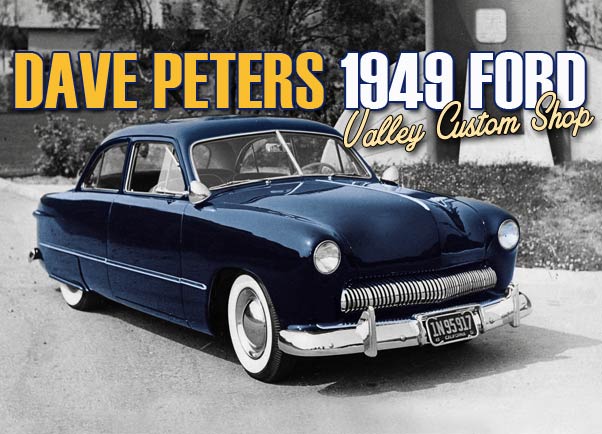
Valley Custom finally is getting its due. Thank you, Rik Hoving. I still have my 1954 Motor Trend Custom Car Annual. The Polynesian had such simple, trim flowing lines. Then, when you compare The Caribbean with the profile of a stock ’39 Mercury convertible, you are looking at sheer genius in “less is more”. What an eye Neil Emory and Clayton Jensen had for the artform in an automobile! How they achieved this slim silhouette is a real tribute to their mastery of their craft. To understand how they achieved this without the radical process of sectioning puts you absolutely in awe.
Yes, Awesome!!!
Larry Pointer
Valley Custom is finally getting its due. Thank you, Rik Hoving. I still have my dog-eared Motor Trend 1954 Custom Car Annual. The Polynesian had such trim, simple flowing lines. The styling genius of Neil Emory and Clayton Jensen perhaps is even better demonstrated in The Caribbean. Compared to the stodgy form of the stock ’39 Mercury convertible, the slim silhouette of The Caribbean is pure art of the automobile. How they were able to create this artwork without the intricate process of sectioning, leaves you in awe of both their design genius but their absolute mastery of their craft.
Awesome!
Larry Pointer
Thanks Larry. Glad you enjoyed the article. You are so right… this one is genius.
The car ended up in Albuquerque, New Mexico and it had a small block chevy in it. Which was removed and put in a 39 chevy pickup. I painted the 39 chevy pickup owned by Eddie Corbin. Then featured in Rod and Custom in either January or February 1963. I got the car from painting the 39 chevy pickup. I still have the license plate, and the number on the license plate is VGP 413, and the sticker expires in 1961. When I moved from Albuquerque to Wisconsin, I couldn’t afford to take it with me, so I sold it to a salvage yard in Tijeras Canyon, and when they changed Route 66 to Interstate 40, the salvage yard was moved, and I dont where it went. The owner of the salvage yard was Bill Liddle, and I don’t what happened aftdr that.
after that*
I would like to know what happened to the car from 1956-61
My home phone number is 1-608-847-7719
You can contact me from that